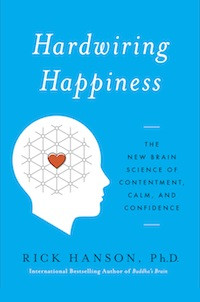Imagine that your mind is like a garden. You could simply be with it, looking at its weeds and flowers without judging or changing anything. Or, you could pull weeds by decreasing what’s negative in your mind. Or, you could grow flowers by increasing the positive in your mind. In essence, you can manage your mind in three primary ways: let be, let go, or let in.
When something difficult or uncomfortable happens—when a storm comes to your garden—these three ways to engage your mind give you a very useful, step-by-step sequence.
 © Fotosmurf03
© Fotosmurf03
First, be with your experience. Observe it and accept it for what it is even if it’s painful. Second, when it feels right—which could be a matter of seconds with a familiar worry or a matter of months or years with the loss of a loved one—begin letting go of whatever is negative. For example, relax your body to reduce tension. Third, again when it feels right, after you’ve released some or all of what was negative, replace it with something positive. For instance, you could remember what it’s like to be with someone who appreciates you, then stay with this experience for 10 or 20 seconds.
Besides feeling good in the moment, this third step will have lasting benefits, for when you take in positive experiences, you are not only growing flowers in your mind. You are growing new neural circuits in your brain. You are hardwiring happiness.
Experience-dependent neuroplasticity
The brain is the organ that learns, so it is designed to be changed by your experiences. It still amazes me but it’s true: Whatever we repeatedly sense and feel and want and think is slowly but surely sculpting neural structure. As you read this, in the five cups of tofu-like tissue inside your head, nested amidst a trillion support cells, 80-100 billion neurons are signaling each other in a network with about half a quadrillion connections called synapses. All this incredibly fast, complex, and dynamic neural activity is continually changing your brain. Active synapses become more sensitive, new synapses start growing within minutes, busy regions get more blood since they need more oxygen and glucose to do their work, and genes inside neurons turn on or off. Meanwhile, less active connections wither away in a process sometimes called neural Darwinism: the survival of the busiest.
All mental activity—sights and sounds, thoughts and feelings, conscious and unconscious processes—is based on underlying neural activity. Much mental and therefore neural activity flows through the brain like ripples on a river, with no lasting effects on its channel. But intense, prolonged, or repeated mental/neural activity—especially if it is conscious—will leave an enduring imprint in neural structure, like a surging current reshaping a riverbed. In the saying in neuroscience: Neurons that fire together, wire together. Mental states become neural traits. Day after day, your mind is building your brain.
This is what scientists call “experience-dependent neuroplasticity,” which is a hot area of research these days. For example, London taxi drivers memorizing the city’s spaghetti snarl of streets have thickened neural layers in their hippocampus, the region that helps make visual-spatial memories; like building a muscle, these drivers worked a part of their brain and grew new tissue there. Moving from the cab to the cushion, mindfulness meditators have increased gray matter—which means a thicker cortex—in three key regions: prefrontal areas behind the forehead that control attention; the insula, which we use for tuning into ourselves and others; and the hippocampus. Your experiences don’t just grow new synapses, remarkable as that is by itself, but also somehow reach down into your genes—into little strips of atoms in the twisted molecules of DNA inside the nuclei of neurons – and change how they operate. For instance, if you routinely practice relaxation, it will increase the activity of genes that calm down stress reactions, making you more resilient.
 Order your copy of Dr. Hanson's latest book, Hardwiring Happiness.
Order your copy of Dr. Hanson's latest book, Hardwiring Happiness.
If you step back from the details of these studies, one simple truth stands out: Your experiences matter. Not just for how they feel in the moment but for the lasting traces they leave in your brain. Your experiences of happiness, worry, love, and anxiety can make real changes in your neural networks. The structure-building processes of the nervous system are turbocharged by conscious experience, and especially for what’s in the foreground of your awareness. Your attention is like a combination spotlight and vacuum cleaner: It highlights what it lands on and then sucks it into your brain—for better or worse.
There’s a traditional saying that the mind takes its shape from what it rests upon. Based on what we’ve learned about experience-dependent neuroplasticity, a modern version would be that the brain takes its shape from what the mind rests upon. If you keep resting your mind upon self-criticism, worries, grumbling about others, hurts, and stress, then your brain will be shaped into greater reactivity, vulnerability to anxiety and depressed mood, a narrow focus on threats and losses, and inclinations toward anger, sadness, and guilt.
On the other hand, if you keep resting your mind on good events and conditions (someone was nice to you, there’s a roof over your head), pleasant feelings, the things you do get done, physical pleasures, and your good intentions and qualities, then over time your brain will take a different shape, one with strength and resilience hard-wired into it, as well as a realistically optimistic outlook, positive mood, and a sense of worth. Looking back over the past week or so, where has your mind been mainly resting?
In effect, what you pay attention to—what you rest your mind upon—is the primary shaper of your brain. While some things naturally grab a person’s attention—such as a problem at work, a physical pain, or a serious worry—on the whole you have a lot of influence over where your mind rests. This means that you can deliberately prolong and even create the experiences that will shape your brain for the better. This is what I call “taking in the good.”
This practice, applied to positive experiences, boils down to just four words: have it, enjoy it. And see for yourself what happens when you do.
The experiences that serve you most
Contemplating your mental garden these days, which flowers would be good to grow? Certain kinds of experiences will help you more than others will.
Negative experiences could still have value for a person. For instance, working the graveyard shift in a bottling plant one summer while in college toughened me up. But negative experiences have inherent negative side effects, such as psychological discomfort or the health consequences of stress. They can also create or worsen conflicts with others. When my wife and I were tired and frazzled raising two young children, we snapped at each other more often. The costs of negative experiences routinely outweigh their benefits, and often there’s no benefit at all, just pain with no gain. Since neurons that fire together wire together, staying with a negative experience past the point that’s useful is like running laps in Hell: You dig the track a little deeper in your brain each time you go around it.
On the other hand, positive experiences always have gain and rarely have pain. The most direct way to grow inner strengths such as positive emotions, determination, and compassion is to have experiences of them in the first place. If you want to develop more gratitude, keep resting your mind on feeling thankful. If you want to feel more loved, look for and stay with experiences in which you feel included, seen, appreciated, liked, or cherished. The answer to the question of how to grow good things inside your mind is this: take in experiences of them. This will weave them into your brain, building up their neural circuits, so you can take them with you wherever you go.
How do we do this, exactly? I explain how to take in the good in great detail in my new book, Hardwiring Happiness. But for starters, perhaps the most basic way to have a positive experience is to notice the good things that already surround us in everyday life.
Try this brief practice designed to help you notice the positive experiences already hovering on the edge of your awareness—a simple way to help you have a positive experience. Then walk through the next two steps of taking in the good, enriching and absorbing that positive experience.
1. Have: Find a pleasant sensation that’s already present in the foreground or background of your awareness. Perhaps a relaxed feeling of breathing, a comfortable warmth or coolness, or a bodily sense of vitality or aliveness. This sensation could be subtle or mild, yet it still feels good. There may be other sensations, or thoughts or feelings, that are uncomfortable, and that’s alright. Just let go of those for now and bring your attention to the pleasant sensation. When you find a pleasant sensation, move into the next step.
2. Enrich: Stay with the pleasant sensation. Explore it a little. What’s it like? Help it last. Keep your attention on it for 10, 20, or more seconds in a row. Come back to it if your attention wanders. Open to this sensation in your mind and body. Without stress or strain, see if it can become even fuller, even more intense. Enjoy it. Let the pleasure of this sensation help keep it going. See if you can embody it through small actions, such as shifting your body to breathe more fully or smiling softly.
3. Absorb: Both during the second step and right after it, intend and sense that the pleasant sensation is sinking into you. People do this absorbing in various ways. Some imagine the experience weaving its way into them like water soaking into a sponge, golden dust sifting down, a jewel placed into the treasure chest of the heart, or a soothing balm. Others simply understand conceptually that the experience is becoming a part of them. In the absorbing, there is a sense of receiving, letting in, softening, and sinking into the experience as it sinks into you.
When you’re done with this practice, see how you feel. Get a sense of what it’s like to take in the good.
If you weren’t able to notice any pleasant sensations, either you were overwhelmed with agonizing pain (I hope not!) or you just need to try it a few times. It’s natural to have difficulties with the first step of taking in the good, and easy to underestimate it. When working with your mind, it helps to have a gentle yet persistent spirit of exploration. Keep looking. If you can’t find something positive right now, maybe it will arise a moment later.
Self-directed neuroplasticity
The science of experience-dependent neuroplasticity shows that each one of us has the power to change their brain for the better—what Jeffrey Schwartz has called “self-directed neuroplasticity.” If you don’t make use of this power yourself, other forces will shape your brain for you, including pressures at work and home, technology and media, pushy people, the lingering effects of painful past experiences, and Mother Nature herself.
On the other hand, in quick, easy, and enjoyable ways right in the flow of your day, you can use the power of self-directed neuroplasticity to build up a lasting sense of ease, confidence, self-acceptance, compassion, feeling loved, contentment, and inner peace. In essence what you’ll do is simple: Turn everyday good experiences into good neural structure. Putting it more technically: You will activate mental states and then install them as neural traits. When you need them, you’ll be able to draw on these neural traits, which are your inner strengths, the good growing in your mind.
You’ll be using your mind to change your brain to change your mind for the better. Bit by bit, synapse by synapse, you really can build happiness into your brain.
And by doing this, you’ll be overcoming its negativity bias: the brain is good at learning from bad experiences, but bad at learning from good ones—if the mind is like a garden, the “soil” of your brain is more fertile for weeds than for flowers. So it’s really important to plant the seeds of inner strengths by repeatedly taking in the good.








Comments